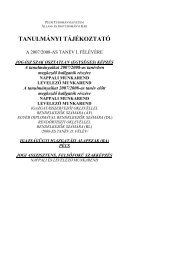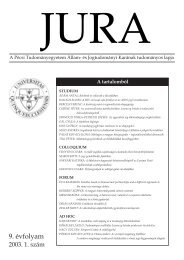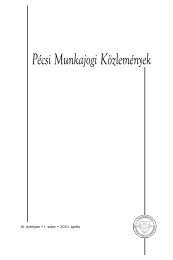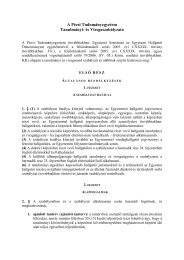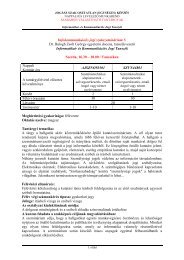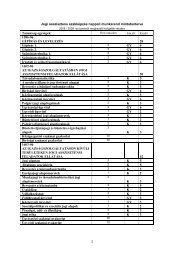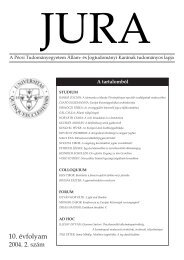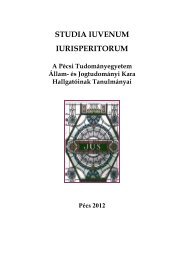2012. évi 2. szám - Jura - Pécsi Tudományegyetem
2012. évi 2. szám - Jura - Pécsi Tudományegyetem
2012. évi 2. szám - Jura - Pécsi Tudományegyetem
- TAGS
- jura
You also want an ePaper? Increase the reach of your titles
YUMPU automatically turns print PDFs into web optimized ePapers that Google loves.
Andityas Soares de Moura Costa Matos: An alternative approach to the basic norm …139and religious norms. Although legal normativismis more than a simple for of logicism, we must lookclosely at the logical structure of the sanction, whichis not simply identical to a penalty, but is rather anormative consequence – positive or negative – inthe logical sense, i.e., it is a result that derives fromthe operative conditions fixed in the first section ofthe norm, by means of which it selects certain actsor facts which are to be interpreted as capable ofcreating law.The legal norm is the most comprehensive andsimpler concept of the legal phenomenon. It is able ofpresent itself either as a rule or as a principle. Hence,many of the criticisms directed at the contemporarynormativism are meaningless. This view has neverdespised the idea of legal principles, which centralto the so-calle “neoconstitucionalism”. Regardingto the studies of Josef Esser and many other authorswho have dedicated their works to the study of thestructural differences between principles and rules– let us remind Aulis Aarnio, Klaus Günther, RobertAlexy e Ronald Dworkin, just to name some of themost prominent –, the contemporary versions of legalnormativism holds that the rules are legal norms thathave a high level of concreteness, acting through abinary logic (either X or Y), while the principles arelegal norms that have higher level of abstractionand, at the time of their application, can be balancedwith one another without creating logical-normativeantinomies. Nevertheless, both rules and principlesare legal norms of a coercive nature and, therefore,part of the legal positivist subject of inquiry.On the other hand, Kelsen insists on the differencebetween the legal norms, as formal objects ofthe science of law, and the juridical propositions(Rechtssätze) that describe them. While legal normsare created by the sources of law, such as legislatorsand judges, the juridical propositions are the resultof a theoretical study of legal norms, leaving its creationonly to the scientist of law. This type of juristdoesn’t create any legal norms, but only describethem through scientific procedures in view of thebasic category that gives them reality, namely thevalidity.Kelsen’s normativism – also called logical normativism– is based on the strict distinction betweenthe spheres of “is” (Sein) and “ought” (Sollen), thatfounded the epistemological dualism between factand value, on the one hand, and cognition and volition,on the other. The legal norm is seen as a possiblescheme of interpretation of the human behaviour,becoming logically an objective sense of acts of will.The objectivity of the legal norms is due to the factthat the lower-level norms base their existence in thesuperior norms, all of them understood systematicallyas elements of the normative pyramid (Stufenbau),whose peak is, in the domestic law of each State,the Constitution. By now, we can conclude that theexistence of the legal norm is formal, not factual.Kelsen doesn’t distinguish the sphere of the existencefrom that of the validity of a norm. As logicalnormativism teaches, both the spheres coincideinto the same concept. The existence of the legalnorm – i. e. its validity – depends on its creation bycompetent authorities and according to the properlegal procedures (that is why the legal normativistsstate that law regulates its own creation). Moreover,a legal norm must be accordance with the contentsof the legal order to which it belongs. The task ofverifying this harmony lies with the law-applyingbodies, which make the so called authentic interpretation.Once existing, the legal norm may or maynot be effective. We name effectiveness the factualproduction of normative effects, which may happenautomatically, as in the case of norms that definecompetences and legal situations or when there is:a) the spontaneous observance of legal duties by thecitizens, or b) the coercive application of negativesanctions by the bodies authorized to do so.Kelsen emphasizes the dissociation betweenthe spheres of validity and effectiveness. While theformer has a formal and logical nature, the latter hasa substantive and sociological character. To be valid,a legal norm doesn’t need to be effective. However, aminimum degree of effectiveness is a condition for itsvalidity, since a valid norm may loose this attributeover time because of its disuse. Notwithstandingthis, the minimum degree of effectiveness is not thebasis of the validity of a norm. This role is actuallyreserved exclusively to the basic norm. The socialnormativity – the fact that people obey to the legalnorms that are believed to be created by a legitimatesource of law – is not sufficient to explain the specificallyjuridical character of a law (Honoré 2007, 101).According to Kelsen, it is necessary to proceed withan objectification of the normative commandment;otherwise we can’t distinguish between the rulesestablished by the State from those made by a groupof bandits. And this is essential for the notion of thebasic norm.Perhaps the most controversial aspect of legalnormativism lies in the definition of the nature of thebasic norm, which is a topic that will be explored indepth in the next section. Kelsen hesitated for yearsin its characterization, classifying it as a legal fiction,based on a work of Vaihinger entitled “Philosophyof As-If” (“Die Philosophie des Als-Ob”), and as a hypothesis,relying on Kant’s interpretation carried outby Cohen. Despite such uncertainty, Kelsen was fullyaware that the notion of the basic norm was the keyJURA 2012/<strong>2.</strong>



